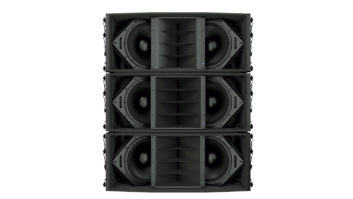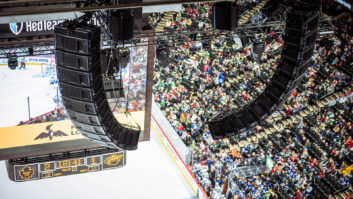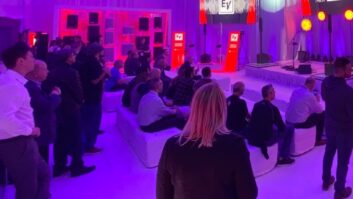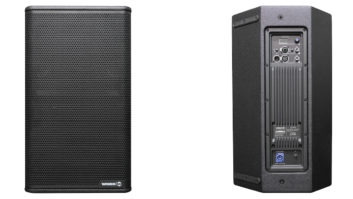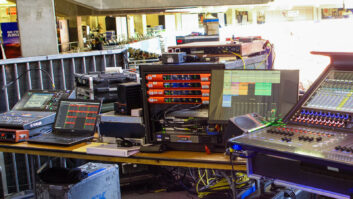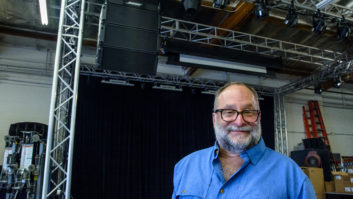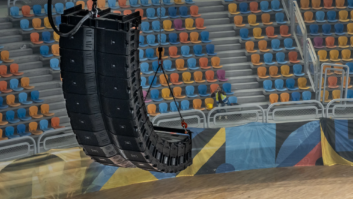These days, just about everything from your DVD player to your coffee machine can be remote-controlled, so why not your power amplifiers? Networked communication for power amp management can make life a lot easier when configuring and tuning industrial sound systems, touring P.A. systems and club/stadium/theater installations. Initially, network communication circuitry was offered as an add-on, but many amplifier manufacturers are now designing their amps with onboard data communication.
Most amplifier networks route control data, but several can route both audio and control information. Many manufacturers use Ethernet hardware, providing a familiar, off-the-shelf interface, with straightforward cabling requirements. The PC can be located anywhere in a venue, yet still allow adjustment of functions as simple as muting or gain, or as complex as multi-band equalization, delay and DSP. As network communication is two-way, amps can “report” various operational data back to the computer in real time, such as input/output clipping, thermal status, output voltage and status of protection circuitry. Complex amplifier networks can support hundreds of power amps (each with a unique identity), all under the control of any number of computers. Typically, the PC can be disconnected once the system is configured, preventing inquiring minds from making unauthorized tweaks or “improvements.”
Listed alphabetically, here’s a look at the latest top-of-the line networked amplifiers for live sound applications. We’ve also included a synopsis of current offerings in network protocols — both proprietary (company-specific) and general-purpose approaches supported by several amp manufacturers.
The Ashly Audio (www.ashly.com) Protea™ Enabled Series 3800 ($2,900) is a high-power, high-efficiency amplifier that can be controlled and monitored via built-in Ethernet using Protea software, providing access to input attenuation, channel mute, channel polarity, output voltage and current, clipping, temperature and remote power on/off. Output is rated 1,900 watts stereo into 4 ohms or 3,000W bridged mono into 4 ohms. Inputs are Neutrik combo connectors and 6-pin Euroblock; XLR male connectors loop out to additional amps. Onboard analog processing includes a subsonic filter, clip limiter and input-sensitivity selector.
Ashly Audio Protea Enabled Series 3800 can be controlled/monitored via built-in Ethernet.
All amplifiers in Ashly’s PE Series accept Protea DSP option cards ($900 each) with a SHARC 32-bit/96kHz processor, enabling 24-bit AD/DA, and analog and digital (AES-3) inputs. Ashly’s DSP library includes EQ, filters with slopes up to 48 dB/octave, delay, compressor/limiter, gate, signal generator and matrix routing.
The VX880 ($2,745) is the flagship model of a new contracting series of amplifiers from BGW (www.bgw.com). The VX880 is capable of putting out 900W per channel into 8 ohms (2,450W bridged) and 1,400W at 70 volts (no transformers required). In addition to balanced XLR and Euroblock inputs, the rear panel features barrier strip output terminals, precision 1dB stepped attenuators for each channel and a switched 30Hz highpass filter (12 dB/octave). Safety features of the VX880 include quiet turn on/off, short protection, and independent DC and thermal-overload protection on each channel, which automatically protects one channel while allowing the other to continue operation (even if one channel is down). A rear panel FaastLink port allows the VX880 to be used with a CobraNet interface for audio routing and amplifier control.
Camco Audio‘s (www.camcoaudio.com) Vortex Series uses a switched-mode power supply to deliver extremely high power levels while reducing weight and dimensions. The two-space Vortex 6 ($4,905) has a rated output level of 2,300W into 4 ohms/both channels driven and 6,600W into 4 ohms/bridged. Protection features include emergency shutdown in case of extreme malfunctions, overvoltage protection of up to 400V, thermal protection for the transistors and hum-free operation in case of extreme undervoltage. Front panel LEDs show operational status and functions; all indicators and controls are available for adjustment via a remote-control network.
Camco’s new UCA DSP-Module allows Vortex amplifiers to become a Universal ControllerAmp with 99 network addresses that are accessible by using the amplifier’s volume controls. Parametric EQ, delay, filters, crossover and limiters are implemented via the Camco WinCai application. The UCA module is fully integrated with the amps, and data exchange is achieved via internal interfaces.
The Crest Audio (www.crestaudio.com) CMi 2208 amp works with the company’s Nx CobraNet-8™ control module using Crest NexSys 4 and Peavey MediaMatrix MWare™ software for advanced control and audio routing. The Nx CobraNet-8 module fits into a CMi 2208 rear bay, supporting all NexSys functions, DSP and CobraNet digital audio I/O on a single Cat-5 Ethernet cable. A four-character LED allows easy setup, control and monitoring of up to eight CobraNet audio channels from the rear panel. DSP options for the Nx CobraNet-8 include delay, EQ, compression/limiting and crossover. Amplifier monitoring includes ACL™ (Active Clip Limiting), IGM™ (Instantaneous Gain Modulation), I/O gain, DC, thermal protect, fault, mute, Ethernet data and link statuses. The CMi 2208 is rated at 150W/side into 4 ohms, 300W bridged into 8 ohms and 200W/channel at 70V.
Crown I-Tech 8000 rear panel
Crown‘s (www.crownaudio.com) I-Tech 8000 ($7,685) is a 2-channel amplifier employing patented Class-I (BCA®) circuitry that combines high output power, low AC current drain and a lighter weight package. A regulated power supply delivers full power regardless of mains voltage from 120V to 277V, 50 to 60 Hz. The I-Tech 8000 features AES/EBU digital audio input and employs onboard DSP with 24-bit/96kHz AD/DA converters for a wide array of signal processing. DSP is performed by the latest 32-bit SHARC digital processors from Analog Devices and includes 64 assignable filters with nine different filter types. User-created and factory-designed DSP presets can be accessed via the front panel. A CobraNet digital audio option integrates TCP/IQ and CobraNet digital audio on a single network connection. Capable of delivering 2,100W/channel into 8 ohms/stereo, the I-Tech 8000 is fully compatible with the Harman Pro HiQnet and the Crown TCP/IQ network.
Distributed by TC Electronic, Lab.gruppen‘s (www.labgruppen.com) C 68:4 ($4,895) provides four channels of amplification, each with a maximum output of 1,700W at 4 ohms. The amp may be configured for use in low-impedance or 70V and 100V applications via rear panel DIP switches, and permits individual channel adjustment of maximum voltage peak output and gain. The C 68:4’s four channels may be bridged in pairs of two for increased output (2,400W at 4 ohms, two channels driven). Balanced input is on 3-pin Phoenix connectors, while output is on terminal strip connectors. Lab.gruppen’s patented Class-TD and regulated switch mode power supply enable the C 68:4 to combine efficient high-power output with reliable operation.
The Lab.gruppen C 68:4 can be configured for low-impedance or 70/100-volt apps via rear panel DIP switches.
As with all Lab.gruppen C Series amps, the C 68:4 incorporates an integrated interface for use with the company’s NomadLink® network. Using NomadLink and DeviceControl software, C Series amplifiers may be controlled and monitored via PC.
The MC1250 from MC2 Audio (www.mc2-audio.co.uk) is a stereo unit offering 1,250W/side into 4 ohms or 3,600W mono bridged. The three-rackspace unit features complementary Class-A/B bipolar outputs, with a unique floating drive stage. Its load, temperature and operating parameters are continually monitored; in case of overheating, the power supply reduces to a safe level, protecting the unit without shutdown. Balanced XLR inputs with parallel output connectors are standard, as are binding post outputs; a 24dB/octave crossover card option is available. Other features include quiet variable-speed fans, a user-selectable clip limiter, dual peak meters, independent/stereo-linkable level controls and a 9-pin D-sub connector for full bidirectional control via RS-485.
At the head of the Digam K Series from Powersoft (www.powersoftaudio.com) is the K 10, a 2-channel amplifier with a max power output level of 4,000W into 4 ohms/stereo and 12,000W at 4 ohms/bridged mono. Intended for touring and installations, the K 10 employs an advanced switch-mode power supply for high performance in a single-space rack chassis. A front panel interactive LCD shows amplifier status, including load impedance, output power, mains voltage and current, and temperature. In addition to digital gain control, the K 10 features built-in (defeatable) clip limiters, user-defined maximum output power per channel and input sensitivity. An optional PowerControlModule interface card mounted inside the unit provides an RJ-45 on the rear panel for connection to an RS-485 network.
QSC CX168 includes DataPorts for remote amplifier management or signal processing.
Designed for permanent installs where space is at a premium, QSC‘s (www.qscaudio.com) CX168 ($2,450) is an 8-channel amplifier delivering 90W/channel at 8 ohms. Each pair of channels may be bridged to configure the amplifier as a 4, 5, 6 or 7-channel unit. Like the entire CX Series, the CX168 includes DataPorts for remote amplifier management or signal processing, as well as QSC’s PowerWave technology for reduced size and weight. Selectable highpass filters protect speakers and prevent speaker transformer saturation with minimal effect on program material, while front panel LEDs indicate signal, clip, bridged mono and parallel input status. The CX168 accepts audio input via rear panel Euroblock or DataPort connectors. An RS port connects the CX168 to a CM16a amplifier network monitor for remote control. The DataPort enables using the CX168 with a variety of QSC expansion modules such as the DSP-3, which adds two channels of independent signal processing.
Yamaha PC9501N’s rear panel features balanced XLR and Euroblock connectors.
The PC9501N ($1,699) is the top of Yamaha‘s (www.yamaha.com) PC-1N Series of networked amplifiers. The PC9501N provides stereo, parallel and bridged-mono output modes, delivering 925W/channel into 8 ohms/stereo and 4,600W bridged mono at 4 ohms. Weighing less than 29 pounds, the PC9501N employs a switching regulator that yields a more stable and balanced supply of voltage and current, and eliminates fluctuations in output level. Each channel features a 31-position input attenuator, highpass filter and 10-segment LED meter. Rear panel input is via balanced XLR and Euroblock connectors with binding post and Speakon output connectors. Dual RJ-45 terminals are included for networking the PC9501N via CobraNet with Yamaha’s ACU16-C amplifier control unit and NetworkAmp software.
In addition to contributing to Mix magazine, Steve La Cerra is an independent engineer currently mixing front of house and tour-managing for Blue Öyster Cult.
UNDERSTANDING NETWORK PROTOCOLS
Networking and interfacing amplifiers is still a relatively new topic to most audio pros. The following are capsule summaries of control protocols used in live sound amplifiers. All companies listed here will provide more detailed information such as specs, white papers and other technical data on request.
Ashly Audio Protea: Running on any PC, Protea Software allows setup, control and monitoring of PE Series amplifiers and Protea processors using standard Ethernet hardware and manual or auto-IP configuration. Monitoring and control functions include input attenuation, mute, channel polarity, output voltage, clipping, temperature and power on/off. PE Series amps accept Protea DSP option cards, which use SHARC processors to operate from 48 to 96 kHz with a 24-bit AD/DA.
Aviom A-Net Pro64: Designed for use with Aviom’s (www.aviom.com) distributed audio products and peripherals, as well as OEM products to other manufacturers, A-Net™ Pro64 supports up to 64 bidirectional audio channels (24-bit/48 kHz) over Cat-5 cable. The system can be expanded in parallel for 128×128-channel support, and includes bandwidth for handling multiple streams of non-audio data, such as MIDI, GPIO and RS-232.
Camco Adaptive Intelligence (CAI): Camco’s amplifier networking and remote control can run from any Windows PC using an Ethernet network card. The company’s WinCai software communicates with an EtherCai Interface, supporting connections for up to 32 amplifiers. Connection is via CAI protocol and RS-485, fully compatible with all CAI-equipped amplifiers and Nexo NX241/2 controllers.
Crest NexSys: NexSys® for Windows allows Crest CK and CKi amplifiers to be controlled and monitored via a PC. NexSys features output and system fault monitoring, speaker control, real-time control of amplifier and signal processing settings, and virtually unlimited snapshot and automation capabilities, as well as programming facilities for Crest’s NC-Class modules, such as the NC-DSP input signal processor or NC-SLM load monitor.
Crown TCP/IQ: Crown’s IQ™ network provides remote control and status monitoring of power amplifiers from central and/or remote locations using IQWic (IQ for Windows) software running on a host PC. IQ Networks perform DSP, automatic mixing, routing, and system and load monitoring. Crown amplifiers featuring PIP slots can accept the IQ-PIP-LITE module for connection to a 100Mb Ethernet network for use with IQ and CobraNet.
EtherSound: Invented by DigiGram and supported by numerous manufacturers, Ethersound (www.ethersound.com) provides bidirectional, low-latency transmission of synchronized audio channels and control data over standard Cat-5/6 Ethernet. Up to 64 channels of 24-bit/48kHz PCM audio, plus embedded control and monitoring data, are transported via a single cable.
Harman HiQnet: HiQnet™ communications protocol is shared by Harman Pro (www.harmanpro.com/hiqnet) brands including AKG, BSS, Crown, dbx, JBL, Lexicon, Soundcraft and Studer. An entire HiQnet system can be configured and controlled using Harman Pro’s System Architect software. The HiQnet protocol is capable of wrapping around the transport medium employed by third-party networked audio protocols such as CobraNet, and supports up to 64 channels of streaming audio.
Lab.gruppen NomadLink: This closed-loop network facilitates control of up to 60 amplifiers. The NLB 60E serves as the bridge between Lab.gruppen’s C Series amps and Ethernet using standard Cat-5 cable for communication of up to 1,000 feet. Local monitoring and control of the amplifiers are possible via the NLB 60E’s front panel or via PC. DeviceControl software facilitates setup, monitoring and control of C Series amps, automatically generating a list of networked amps and channels.
Peak Audio CobraNet: Peak Audio’s (www.peakaudio.com) CobraNet is open to any manufacturer that wishes to license the technology for use in its gear. CobraNet has the capacity to carry 64 channels of 48kHz/20-bit audio, plus control data over a single Cat-5 cable. CobraNet is currently supported by Crest, Crown, Peavey, QSC and Yamaha.
Peavey MediaMatrix: MediaMatrix™ now encompasses more than 16 products. The audio system is contained in the MediaMatrix frame, processed by a DSP farm of multiple digital processing unit cards, replacing mixers, routers, compressors, equalizers and crossovers in conventional audio systems. Larger MediaMatrix systems may incorporate CobraNet for routing digital audio or the XControl® Series of programmable, flush-mount control panels.
Powersoft PowerControl: The PowerControl System is designed for monitoring and amplifier control in real time. Main system components include PowerControl Manager software (running on any PC), a PowerControl hub unit and a PowerControl board installed inside the amplifier. A single PC can manage up to 99 units with the provided software.
QSControl.net: This is QSC’s latest network for control, processing and amplifier monitoring of the company’s BASIS and next-generation RAVE and DSP products from a single graphic software interface. Multiple networked computers can control and monitor all devices simultaneously. QSControl.net supports amplifier and loudspeaker control, monitoring and protection, as well as CobraNet for up to 32 channels of audio I/O.
Yamaha NetworkAmp Manager: NetworkAmp software for Windows combines with Yamaha’s ACU16-C amp control unit to instantaneously relay and handle a variety of crucial data concerning the connected amplifiers and speakers through the network using the DATA ports on each connected unit. A single ACU16-C can control up to 32 separate PC-1N Series amplifiers. Adding the optional NHB32-C network hub/bridge facilitates monitoring and control of the entire system via CobraNet.
